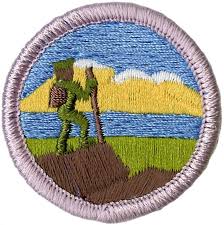The Hiking merit badge is one of the three fitness-related badges that Eagle Scouts must choose from—alongside Swimming and Cycling. While it may not require a pool or bike, it absolutely requires determination, preparation, and endurance. For Scouts who love the outdoors and the challenge of going the distance on foot, this badge is the perfect test of skill and stamina.
Earning this badge means planning and completing five rigorous hikes—including a 20-mile trek in a single day—as well as learning how to hike safely, take care of your body on the trail, and prepare for every outdoor condition. The Hiking merit badge is not for the unprepared, but it is incredibly rewarding for those who embrace it.
Timeframe / Difficulty
The Hiking merit badge is one of the more physically demanding Eagle-required options, often taking 2–4 months or more to complete. While there are no advanced techniques to master, the distance hikes require physical training, planning, and a commitment to see the process through.
Most Scouts spread out their hikes over several weeks or months, depending on weather, terrain, and access to hiking trails. The 20-mile hike alone is a major milestone, both physically and mentally.
This badge is rated as moderate to high in difficulty, especially due to the physical effort and time commitment needed to complete all five hikes.
Tips for Success
1. Train like you’re working up to a marathon.
Start walking and hiking short distances each week and build up gradually. Wear your actual hiking shoes and pack to break them in and condition your body.
2. Don’t underestimate planning.
Each hike requires a written plan that includes maps, gear, food, and clothing. Use these to stay safe and organized—and to help get counselor approval.
3. Track your hikes with a logbook or app.
Record your mileage, route, and observations to make the write-ups easier later. Apps like AllTrails or Gaia GPS can help plan and document your trips.
Complete Guide to the Hiking Merit Badge
This guide is only intended as a starting point for your research. Directly copying the information offered here is plagiarism. Doing your own research will allow you to get the most out of this badge and maintain the 12 points of the scout law. A scout is trustworthy!
Below is a requirement-by-requirement breakdown of the Hiking merit badge, with explanations and tips for each step.
Requirement 1
1. Do the following:
(a) Explain to your counselor the most likely hazards you may encounter while hiking, and what you should do to anticipate, help prevent, mitigate and respond to these hazards.
(b) Show that you know first aid for injuries or illnesses that could occur while hiking, including hypothermia, frostbite, dehydration, heat exhaustion, heatstroke, sunburn, hyperventilation, altitude sickness, sprained ankle, blisters, insect stings, tick bites, and snakebite.
Tips:
- Hazards include weather changes, rough terrain, getting lost, wildlife encounters, and fatigue.
- Prevention starts with preparation: bring the 10 essentials, check the weather, know your route, and hike with a buddy.
- Review first aid treatments, especially for heat- and cold-related illnesses, and make sure your first aid kit is trail-ready.
- Practice basic first aid scenarios with your troop or family before your hikes.
Requirement 2
2. Do the following:
(a) Explain and, where possible, show the points of good hiking practices including proper outdoor ethics, hiking safety in the daytime and at night, courtesy to others, choice of footwear, and proper care of feet and footwear.
(b) Read aloud or recite the Leave No Trace Seven Principles, and discuss why each is important while hiking.
(c) Read aloud or recite the Outdoor Code, and give examples of how to follow it on a hike.
Tips:
- Good hiking practices include: start early, pace yourself, stay on marked trails, hydrate, rest periodically, and care for your gear.
- Footwear matters. Use broken-in hiking boots or trail shoes appropriate for your terrain.
- Learn the Leave No Trace principles and be ready to apply them to real scenarios (e.g., how to dispose of waste properly, or minimize trail damage).
- The Outdoor Code ties directly into your role as a responsible hiker—be clean, careful, considerate, and conservation-minded.
- I discussed both in the Outdoor Code and Leave No Trace in a post you can find here.
Requirement 3
3. Explain how hiking is an aerobic activity. Develop a plan for conditioning yourself for 10-mile hikes, and describe how you will increase your fitness for longer hikes.
Tips:
- Hiking increases your heart rate and uses large muscle groups over an extended period—making it an excellent aerobic (cardio) activity.
- Conditioning includes walking or hiking 2–3 times per week and gradually increasing distance, speed, and elevation.
- Include stretching, strength training (especially legs and core), and hydration in your routine.
Requirement 4
4. Take four 10-mile hikes and one 20-mile hike, each on a different day, and each of continuous miles. Prepare a written hike plan before each hike and share it with your counselor or a designee for approval before starting the hike. Include map routes, a clothing and equipment list, and a list of items for a trail lunch. You may stop for as many short rest periods as needed, as well as one meal, during each hike, but not for an extended period such as overnight.
(a) 10-mile hike #1
(b) 10-mile hike #2
(c) 10-mile hike #3
(d) 10-mile hike #4
(e) 20-mile hike
Tips:
- Your hike plan should include a trail map (digital or paper), weather forecast, what you’re wearing, what gear you’re bringing, and what food you’ll eat.
- Choose hikes with varied terrain to challenge yourself and keep things interesting.
- For the 20-mile hike, plan to spend most of the day hiking. Start early, pace yourself, and eat small amounts frequently.
Requirement 5
5. After each of the hikes (or during each hike if on one continuous “trek”) in requirement 4, write a short report on your hike. For each hike, give the date and description (or map) of the route covered, the weather, any interesting things you saw, and any challenges you had and how you overcame them. It may include something you learned about yourself, about the outdoors, or about others you were hiking with. Share this with your counselor.
Tips:
- Don’t wait too long after the hike to write your report—record the details while they’re fresh.
- Describe the terrain, flora and fauna, weather, and any personal lessons learned.
- Include maps or screenshots of your tracked route if using a GPS app.
- Be honest and reflective—what challenged you? What motivated you? What would you do differently?
Conclusion
The Hiking merit badge is more than just long walks through nature—it’s a test of preparation, perseverance, and personal growth. You’ll push yourself physically, learn to plan and lead in the outdoors, and come away with stories and confidence that will last a lifetime.
If you’re aiming for Eagle Scout, don’t miss our other required badge guides:
For official Hiking merit badge requirements, visit Scouting.org.
Get your boots on, your pack ready, and hit the trail. You’ve got miles to go—and memories to make!





